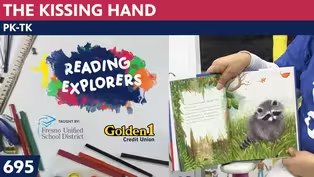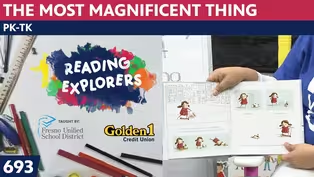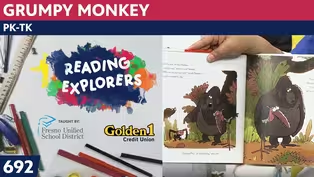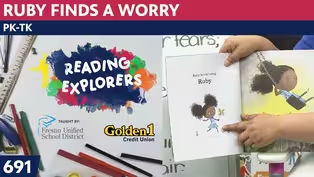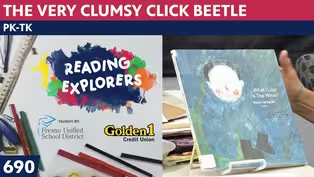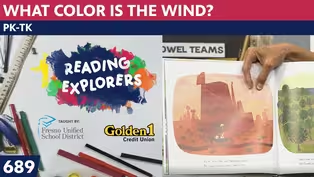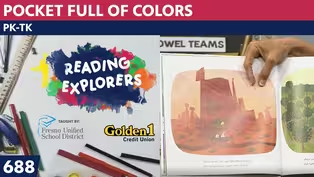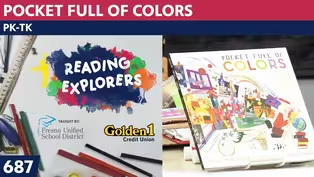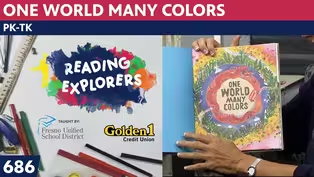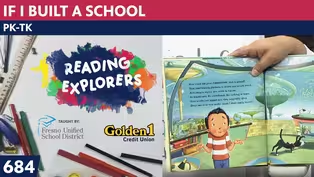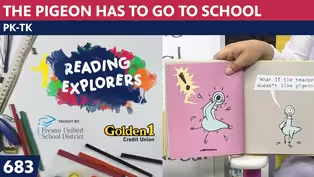
TK-337: Henri Matisse
Season 3 Episode 198 | 14m 13sVideo has Closed Captions
Join Mrs. Readwright at Camp Discovery!
Transitional Kindergarten teacher, Mrs. Readwright, welcomes students back to Camp Discovery, a fun learning space packed with reading adventures & fun games!
Problems playing video? | Closed Captioning Feedback
Problems playing video? | Closed Captioning Feedback
Reading Explorers is a local public television program presented by Valley PBS

TK-337: Henri Matisse
Season 3 Episode 198 | 14m 13sVideo has Closed Captions
Transitional Kindergarten teacher, Mrs. Readwright, welcomes students back to Camp Discovery, a fun learning space packed with reading adventures & fun games!
Problems playing video? | Closed Captioning Feedback
How to Watch Reading Explorers
Reading Explorers is available to stream on pbs.org and the free PBS App, available on iPhone, Apple TV, Android TV, Android smartphones, Amazon Fire TV, Amazon Fire Tablet, Roku, Samsung Smart TV, and Vizio.
Providing Support for PBS.org
Learn Moreabout PBS online sponsorshipMore from This Collection
Valley PBS and Fresno Unified School District have partnered with Golden 1 Credit Union to create Reading Explorers Lessons for grades Pre-Kindergarten through Third grade. The daily lessons will be taught by Fresno Unified School District teachers and are created to help students practice their reading skills and reinforce lessons during distance learning.
Video has Closed Captions
Valley PBS presents Reading Explorers Lessons for Pre-Kindergarten and TK. (26m 27s)
PK-TK-693-The Most Magnificent Thing
Video has Closed Captions
Valley PBS presents Reading Explorers Lessons for Pre-Kindergarten and TK. (26m 26s)
Video has Closed Captions
Valley PBS presents Reading Explorers Lessons for Pre-Kindergarten and TK. (26m 28s)
Video has Closed Captions
Valley PBS presents Reading Explorers Lessons for Pre-Kindergarten and TK. (26m 28s)
PK-TK-690: The Very Clumsy Click Beetle
Video has Closed Captions
Valley PBS presents Reading Explorers Lessons for Pre-Kindergarten and TK. (26m 22s)
PK-TK-689: What Color is the Wind?
Video has Closed Captions
Valley PBS presents Reading Explorers Lessons for Pre-Kindergarten and TK. (26m 21s)
PK-TK-688: Pocket Full of Colors
Video has Closed Captions
Valley PBS presents Reading Explorers Lessons for Pre-Kindergarten and TK. (25m 58s)
PK-TK-687: Dancing Through Fields of Colors
Video has Closed Captions
Valley PBS presents Reading Explorers Lessons for Pre-Kindergarten and TK. (26m 20s)
PK-TK-686: One World Many Colors
Video has Closed Captions
Valley PBS presents Reading Explorers Lessons for Pre-Kindergarten and TK. (27m 13s)
PK-TK-685: School is Wherever I am
Video has Closed Captions
Valley PBS presents Reading Explorers Lessons for Pre-Kindergarten and TK. (26m 32s)
PK-TK-684: If I Built a School
Video has Closed Captions
Valley PBS presents Reading Explorers Lessons for Pre-Kindergarten and TK. (26m 21s)
PK-TK-683: The Pigeon Has to Go to School
Video has Closed Captions
Valley PBS presents Reading Explorers Lessons for Pre-Kindergarten and TK. (26m 22s)
Providing Support for PBS.org
Learn Moreabout PBS online sponsorship♪ Good morning to a brand new day ♪ ♪ Time to learn and games to play ♪ ♪ Learning things is so much fun ♪ ♪ Learning is good for everyone ♪ (playful music) - Hello, early learners.
Welcome back to the art room.
It's me, Mrs. Readwright.
Let's start off with our hello song.
♪ Hello, nice to see you, everyone ♪ ♪ Hello, nice to see you, everyone ♪ ♪ Hello to you, hello to you ♪ ♪ Hello to you, hello to me ♪ ♪ Hello, nice to see you, everyone ♪ Alrighty.
We're doing the ABCs of art.
And today is the letter G. And letter G is for goldfish.
G is for goldfish like these ones in a jar.
They swim in a circle and they don't get very far.
Hey, jar, far, they both say ar.
There's our rhyming words.
Each of these jingles that I've written for the pictures all have rhyming words and we should point those out each week so that you get better and better at your rhyming.
Now, this jar of goldfish was painted by our artist, Henri Matisse.
And when we learned about Henri Matisse, we found out that he started out being a lawyer just like his father wanted him to but he became an artist and he loved his art so much but he used to do kind of dark colors until he met Suzanne.
And Suzanne told him let's brighten things up.
Let's paint outside.
Let's take a look at that kind of art.
So he started doing that and then remember he got sick and he couldn't do his art standing up and painting.
So he was lying down in bed and cutting things out.
That's what I brought a picture of.
Henri Matisse cutting out paper.
And he would have his assistants put it on the walls.
Some of you might have been here when we cut out the picture of the swimmers and he had lived in a hotel where the swimmers swam around the lobby of his room and he continued to do art for a very long time.
But today we're going to do the gold fish.
Let's sing our ABCs of art song.
And then we'll start doing our goldfish art.
♪ It's A, B, C, D, E of art ♪ ♪ That's the way that we will start ♪ ♪ F is for fish, goldfish starts with a G ♪ ♪ H is for house, now don't you see ♪ ♪ I is for insect, jar starts with J ♪ ♪ Art and alphabet, what do you say ♪ Let me set this aside and get my little table up here because we're going to draw a goldfish bowl and a table and you can put decorations all around yours.
I'm not sure how I'm going to do mine.
You know, when I tell you bring coloring tools, I say coloring tools because I don't know what you have at home.
So if you have watercolor pencils, use those.
If you have crayons at home, use those.
If you like to use your pastels, use those.
You get to decide because guess who's art this is?
It's yours.
All right, the other thing about doing this project that I think that you will like is that we're going to learn to draw a cylinder and you'll use a cylinder in your art a lot.
There are times that you'll need to do, oh, the silo for a barn or there might be a time where you're going to make a jar of jam.
So learning how to draw a cylinder is really helpful for an artist.
I'll use my colored pencils.
I brought both my watercolor pencils and I brought my regular colored pencils.
And you can see that's called mixed media.
If you want to use more than one kind of material for your coloring tools, you'll do that.
And it's just called mixed media.
Let me turn these around.
I brought my pencil sharpener 'cause you remember how they're soft.
And I sometimes break them when I draw them.
All right, let's start off with our first cylinder.
And I look to see it's about a third of the way down to start the top of the cylinder.
So all it is, is a flattened out circle and I'll press kind of hard so you can see.
So here is my cylinder.
Do you see how it's an oval?
It's a flattened out circle.
What you do next is decide how tall you want the jar to be.
And remember I say just draw it with your fingers, draw it with your fingers and see how far you want because I also wanna do a table underneath.
So starting at the very edge of my oval.
I will bring it straight down as straight as I can.
And I go across from that without drawing.
I'm just seeing.
I want it to start at the same place so I can use my fingers to measure.
Right there, I put a dot.
And I look at this and I think, oh, I'm gonna draw over here and just have my pencil mark hit my finger.
So it's about the same size.
But if I made it too long I just make this one a little longer.
Now, here's the trick that happens.
Sometimes people don't remember that the bottom of the cylinder has to be curved just like that.
So I'm going to make a curve line that goes that same way.
And you remember what I do?
I kind of curve it with my, don't draw.
I first just test it out.
I either use my finger or do my pencil.
Whoop, whoop, whoop.
And I test it.
There we go.
Now I'm putting, oh, I did pretty great.
Now, in order to make the water line I started on the lower part of my cylinder.
Let me show you what it looks like to you.
I can't draw it upside down, boys and girls, or it'll look crazy, but I want you to see how this has the flattened oval, two straight lines, and then a curve line at the bottom.
Okay, let me turn it back to me.
And I will look to see how to do the water.
So I touch here.
I have to go over and touch the jar a little bit.
Curve it around, touch the jar a little bit.
And go back up to the lip.
Now, look at this for you.
I touch.
Look, it's over just a little bit.
Touch, touch the jar.
Curve it, touch the jar, curve it up.
That's the waterline.
'Cause if you have the water all the way to the top the fish might jump out.
You don't want that to happen.
All right, next in Henri Matisse's work, there are four fish.
Decide how many fish you want.
And I'm going to make some of them light orange and some of them dark orange.
Now, drawing fish yesterday might help you now.
And this is why I decided to do this was to do this following so that you can practice your fish.
It's like an eye, but didn't close up at the end and then I'd make part of a triangle there.
That fish looks pretty good.
I'm going to color him in.
Remember, I'm using watercolor pencils so I don't have to get it all colored.
Some of it can be white.
Some of it can be the orange drawing.
I'm gonna make this fish above him and I'm going to make the eye shape.
See, I have him swimming toward him.
Line up, line up and cross the tail in there.
Now I'm gonna color that in but I might add some other colors on him.
The other thing I'm forgetting to put on here.
There are other fish gills and fins that I might, I like this little one down here to show.
So I'm gonna color that one in 'cause that one makes him look like he really knows how to steer himself around.
This one here.
It's not a foot.
It's like a little fin.
I'm gonna put a little bit yellow, yellowish orange fish.
Well, you won't be able to see him very well until I paint it in, but I'm making it at that eye shape.
Like an eye when you're drawing a person, that kind of eye, not a letter I. I might just do three fish for right now.
Let me put my pencils down.
I'm gonna use that fancy brush I brought yesterday.
The one that already has water in it.
And I'm going to paint it in.
I try and stay in the line.
Sometimes if I rush, it will go out of the line and that doesn't make me happy about my work.
So I just say, take your time Mrs. Readwright.
Just swish it in there like that.
Then I'll get this little fin and I'll swish over here.
Oh, I mixed a little of that darker orange with this lighter orange.
I like how it looks though.
Hey, it's painting in pretty nicely.
Now, in order to make some lines on the fish, 'cause I think it looks good when the scales show, I'll just use my regular colored pencils.
And in order for this to look like they're in water, we need to do a little bit of water.
So I'm going to use some of the blue and color in up here.
So it looks like there's water in this.
Remember, I'm telling you, this is my watercolor pencil.
So I don't have to get it super dark in there but I'll show you with my regular pencil in case that's what you have.
So I'm gonna swim it around.
And make it be watery by not painting it all in one area.
I can just make it go around it and then swirl it around like water.
Very good.
All right, I'm gonna wash that out a little bit, but now I'm going to bring over these colored pencils so you can see how I'm going to use my regular colored pencils.
Maybe I'll use this to color some lines on my fish to make it look like it has scales.
So I can draw it on there like that.
It looks like a little number three in row in a row.
Number three, number three, number three, number three, number three, number three, three, three, three.
It's just a wiggly wobbly line.
And I think I might put some other color, a darker one.
Which one?
This one.
I'll put some stripes on his tail and this one could have some stripes on his tail and some nice scales on him.
Going up here like this.
Now I wanted to show you how to make the table.
I'm gonna set this aside so I don't knock it over while I'm drawing my table.
Now, in this picture of let me just drag it down here.
This has a purple table around it and it has some lemons with some leaves on it.
So now to make the purple table, I'm going to show you, I'm going part way up my dish.
I'm gonna put a little line out here like this.
Let me show you.
I'm gonna make the purple table go all the way around and meet that line.
So I'm going to go all the way around, and come up and meet that line.
And then I can just, I'm using my colored pencil that is worked with the watercolor so I can make it like this.
If I was using the colored pencil like you probably have, then I would not color it back and forth, back and forth, back and forth.
I would do this.
I would go on the side and go on the edge in order to make the table look like it's coming around in a circle and be a form rather than just a shape.
Then you remember you shade it in.
I'm gonna use a giant brush to fill in 'cause it's a big area.
And see how it melts that pencil into watercolor?
That's the fancy part about a watercolor pencil.
I bought mine, I think I told you a long time ago that I bought it at the gift shop in Yosemite when I was hiking there.
I went into the Ansel Adams Gallery and I said, "What kind of pencils are those?"
And the lady told me, "Oh, those are watercolor pencils."
And I thought, oh, I need those.
Now look how I painted that around.
And where my regular colored pencil was?
You can see it does shade it around there and makes it look like it's around your table.
And I can do that around here too, and make it around here.
Now that's my purple table.
I might have to put the legs on.
So I'll put some legs down and go down like that.
You can make your table legs any way you want.
I have a lot more to do on here.
And I think that I need to think about what I want in the background.
Like they have leaves coming out from here.
Of course I picked up a broken one.
But you know, boys and girls, tomorrow we're gonna do house art with Hundertwasser.
And you'll need white paper, colored pencils, or any coloring tools you would like to make.
So if you'll join me tomorrow and if you'll take pictures of your art so I can see and if you send it to me, you know they send these out.
I would love to have you get some mail boys and girls.
Until tomorrow, have a great day.
Do well in school.
And I'll see you tomorrow.
Bye, bye.
♪ Good morning to a brand new day ♪ ♪ Time to learn and games to play ♪ ♪ Learning things is so much fun ♪ ♪ Learning is good for everyone ♪
Support for PBS provided by:
Reading Explorers is a local public television program presented by Valley PBS
